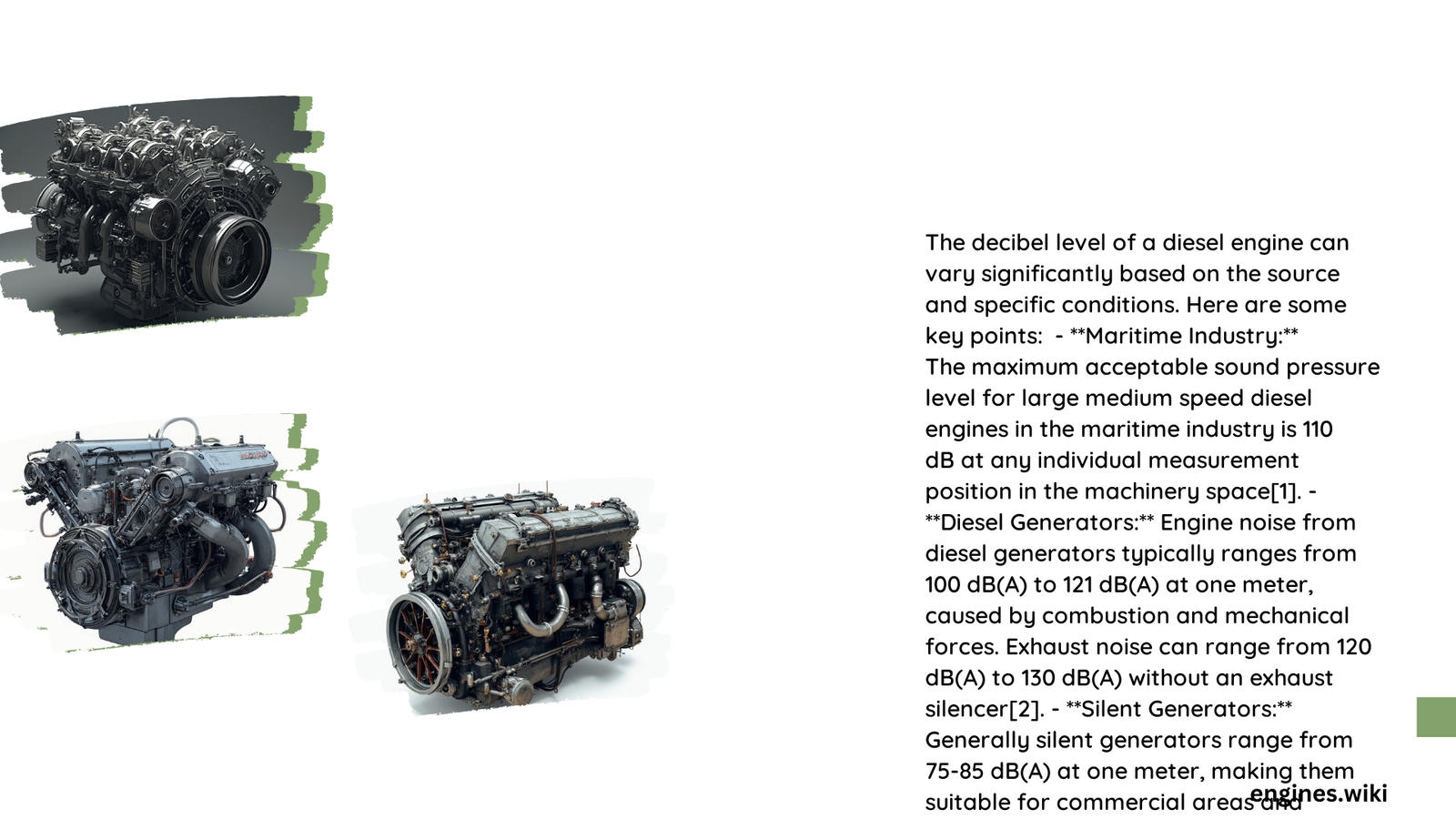Diesel engine decibel level is a critical factor in environmental and occupational health. These engines, known for their efficiency and power, can produce significant noise pollution. Regulations vary globally, with some countries imposing strict limits on diesel engine noise. Typical diesel engine noise levels range from 70 to 125 dB(A), depending on the engine size and application. Noise reduction techniques, including advanced engine design and sound-dampening technologies, are crucial for meeting regulatory standards and improving environmental quality.
What Are the Current Diesel Engine Decibel Level Regulations?
Diesel engine noise regulations vary significantly across different regions and applications. Here’s an overview of the current landscape:
United States Regulations
In the United States, there’s no specific federal regulation for diesel engine noise levels. However, various laws and standards apply:
- Vehicle Exhaust Noise: Many states limit vehicle exhaust noise to 95 dB(A) or less, based on Society of Automotive Engineers (SAE) Standard J1169.
- Industrial Applications: Local noise ordinances often regulate industrial equipment, including diesel generators, with limits typically measured at property lines.
European Union Regulations
The EU has more stringent regulations:
- Outdoor Equipment Directive 2000/14/EC: Sets noise emission limits for outdoor equipment, including some diesel-powered machinery.
- Vehicle Noise Regulations: EU Regulation No 540/2014 sets progressive noise limits for motor vehicles, including those with diesel engines.
How Do Diesel Engine Decibel Levels Compare Across Different Vehicle Types?

Diesel engine noise levels can vary significantly depending on the vehicle type and application. Here’s a comparison:
| Vehicle Type | Typical Decibel Range | Notes |
|---|---|---|
| Heavy-Duty Trucks | 100-125 dB(A) | Comparable to a jet plane at 1,000 feet |
| Buses | 100-120 dB(A) | Similar to heavy-duty trucks |
| Passenger Vehicles | 70-90 dB(A) | Quieter due to better insulation and stricter regulations |
| Construction Equipment | 90-120 dB(A) | Varies widely based on specific machinery |
What Are Effective Diesel Engine Noise Reduction Techniques?
Several techniques can significantly reduce diesel engine noise:
- Engine Design Improvements
- Advanced turbocharging
- Improved fuel injection systems
-
Enhanced internal combustion controls
-
Sound-Reduction Enclosures
- Can reduce noise by up to 40 dB(A)
-
Custom-designed for specific engines or generators
-
Mufflers and Silencers
- Reactive silencers: Best for low to mid-range frequencies
- Absorptive silencers: Effective for high-frequency noise
-
Combination silencers: Address a wide range of frequencies
-
Vibration Isolation
- Use of rubber mounts and dampers
- Reduces structure-borne noise transmission
How Are Diesel Engine Decibel Levels Measured?
Accurate measurement of diesel engine noise is crucial for regulatory compliance and noise reduction efforts:
Required Equipment
- Calibrated sound level meters meeting IEC or ANSI standards
- Acoustic calibrators for on-site verification
Measurement Conditions
- Free field conditions (open area without obstructions)
- Specified distances from the engine (typically 1 meter for close-range measurements)
- Multiple measurement points to create a sound map
Measurement Protocols
- Set up the sound level meter at the specified distance and height.
- Ensure the engine is at operating temperature and running at the specified load.
- Take measurements in dB(A) to account for human ear sensitivity.
- Record measurements over a specified time period (e.g., 15 seconds to 1 minute).
- Repeat measurements at different engine speeds and loads as required.
What Are the Health Impacts of High Diesel Engine Decibel Levels?
Exposure to high noise levels from diesel engines can have significant health impacts:
- Hearing Loss: Prolonged exposure to noise levels above 85 dB(A) can cause permanent hearing damage.
- Stress and Cardiovascular Issues: Chronic noise exposure can lead to increased stress levels and cardiovascular problems.
- Sleep Disturbance: Nighttime noise from diesel engines can disrupt sleep patterns, affecting overall health.
- Cognitive Performance: High noise levels can impair concentration and cognitive function.
How Can Diesel Engine Noise Be Mitigated in Urban Environments?
Urban areas face particular challenges with diesel engine noise. Mitigation strategies include:
- Urban Planning
- Zoning regulations to separate noisy industrial areas from residential zones
-
Noise barriers along major transportation routes
-
Vehicle Restrictions
- Low-noise zones in city centers
-
Time restrictions on heavy vehicle traffic in residential areas
-
Incentives for Quieter Technologies
- Tax breaks or subsidies for low-noise diesel engines or electric alternatives
-
Stricter noise emission standards for urban-use vehicles
-
Public Transportation Improvements
- Investment in quieter bus fleets
- Electrification of public transport systems
What Future Technologies Might Reduce Diesel Engine Noise?
Emerging technologies hold promise for further reducing diesel engine noise:
- Active Noise Control: Electronic systems that generate anti-noise to cancel out engine noise
- Advanced Materials: New composites and alloys that provide better sound insulation
- Hybrid and Electric Systems: Integration of electric motors to reduce reliance on diesel engines
- Smart Exhaust Systems: Adaptive mufflers that adjust to different engine operating conditions
By implementing these technologies and strategies, the impact of diesel engine noise on urban environments and public health can be significantly reduced, while maintaining the efficiency and power that make diesel engines valuable in many applications.
References:
1. Mid-America Engine: What are Noise and DBA in Diesel Generators?
2. WPower Products: Noise Pollution in Diesel Generators – Problems & Solutions
3. World Population Review: Exhaust Laws by State 2024
